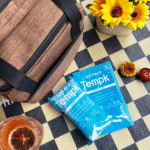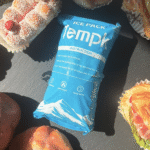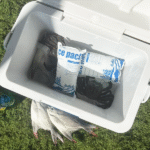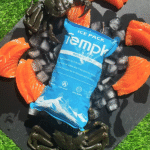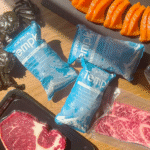How Thermal Dry Ice Packs Keep Shipments Cold
Keeping temperature sensitive goods safe is essential in today’s global supply chains. Thermal dry ice packs combine the power of solid carbon dioxide with specialized insulation to maintain ultra low temperatures for hours or days. Unlike gel packs or water ice, they remain dry, absorbing heat as dry ice sublimates at –78.5 °C and preventing condensation. This guide walks you through how these packs work, bagaimana mengukurnya, safety guidelines and the trends shaping cold chain logistics in 2025. Pada akhirnya, you’ll understand why thermal dry ice packs are a game changer for pharmaceuticals, food and biotechnology.
What are thermal dry ice packs and how do they work? Learn about their layered design, sublimation process and benefits for temperature control.
How do you choose and size thermal dry ice packs for different shipments? Get practical formulas and tables to determine how much dry ice you need and how to place it.
How do thermal dry ice packs compare with gel packs and phase change materials? Understand the pros, cons and best use cases for each cooling method.
What safety, regulatory and sustainability issues should you consider? Discover handling tips, hazard avoidance and eco friendly innovations for 2025.
What Are Thermal Dry Ice Packs and How Do They Work?
Thermal dry ice packs are advanced cooling sheets that encase dry ice within insulated layers to deliver sustained, ultra cold temperatures for sensitive shipments. Each sheet features a dry ice core, sebuah insulation layer that minimizes heat transfer, dan a protective outer layer that is durable and lightweight. When the dry ice sublimates—turning directly from solid to gas—it absorbs heat from the surrounding environment, keeping products at the required temperature.
Unlike standard gel packs, which freeze around 0 °C and gradually melt, thermal dry ice packs maintain temperatures well below freezing, making them suitable for long distance shipments or goods that require deep freezing. Their dry nature eliminates the risk of water damage or soggy packaging that often occurs with traditional ice. Because the insulation layer slows the sublimation rate, these packs can provide consistent cooling for several hours or days, depending on the size of the sheet and external conditions.
Key Components of Thermal Dry Ice Packs
Thermal dry ice packs are engineered with multiple layers to maximize efficiency and safety. Each component plays a specific role in maintaining low temperatures and protecting your shipment.
| Komponen | Fungsi | Pentingnya |
| Lapisan isolasi | Minimizes heat transfer | Keeps cold air inside and reduces the rate at which dry ice sublimates |
| Dry ice core | Provides cooling power | Sublimation of dry ice absorbs heat and maintains ultra low temperatures |
| Protective outer layer | Durable and lightweight | Shields the dry ice and insulation from damage and ensures easy handling |
Thermal dry ice packs are available in various sizes and formats. Sheets or mini slabs can be wrapped around irregularly shaped items, while bricks or pellets provide longer cooling durations. Because the insulation and protective layers are built into the sheet, handling becomes simpler and safer than dealing with loose dry ice. That’s why thermal dry ice packs are increasingly used across industries where maintaining precise temperatures is non negotiable.
Practical Tips for Maximizing Performance
Pre freeze your products: Ensure your goods start at the desired temperature by freezing them for at least 24 hours before packing.
Position the pack correctly: Place thermal dry ice packs above or around the product so the cold CO₂ gas sinks and envelops the cargo.
Conduct trial runs: Test your pack configuration on your longest route, log temperature and weight loss, then refine the pack size.
Choose the right format: Larger slabs or bricks sublimate slowly, making them ideal for long routes; scored sheets or mini slabs wrap around irregular loads and fit mixed shipments.
Use adequate insulation: Pair thermal dry ice packs with insulated containers or vacuum panels to prolong cooling and reduce sublimation.
Real world example: A seafood exporter in 2025 reduced thaw losses from 7 % ke 1.5 % by switching from water ice to thermal dry ice packs. By using vented lids, adding liner insulation and placing packs above the cargo, they maintained consistent temperatures and improved customer satisfaction.
Selecting and Sizing Thermal Dry Ice Packs for Different Shipments
Sizing thermal dry ice packs correctly is crucial for maintaining product integrity while controlling costs. The amount of dry ice you need depends on the product’s temperature requirements, Durasi Pengiriman, container insulation and ambient conditions. A common starting point is 5–10 lb es kering per 24 jam. Beberapa produk, seperti obat -obatan, may require 5–10 lb per hari to maintain –20 °C to –70 °C, whereas seafood may only need 1–2 lb for 24 jam at –18 °C to –20 °C.
Thermal dry ice packs come in different grades, so select the appropriate thickness and weight for your shipment. If your goods need to stay frozen for 72 jam, choose larger packs or multiple sheets, and consider using vacuum insulated containers to reduce the quantity of dry ice required. For mixed temperature loads, use partitions or combine thermal dry ice packs with gel packs or phase change materials to maintain separate zones.
Sizing Guidelines by Shipment Type
The table below summarizes recommended amounts of dry ice for common shipment categories. These values assume thermal dry ice packs with integrated insulation and typical container quality.
| Jenis pengiriman | Recommended dry ice weight (lb) | Lamanya | Kisaran suhu | Practical implications |
| Farmasi | 5–10 lb per 24 H | 24–72 jam | –20 °C to –70 °C | Ultra cold biologics require heavier packs; plan for longer duration shipments |
| Hidangan laut | 1–2 lb per 24 H | 24 H | –18 °C to –20 °C | Lightweight packs suffice for short frozen deliveries |
| Biotech samples | 5 lb per 24 H | 48 H | –20 °C to –50 °C | Use medium sized packs and insulated containers |
| Frozen food deliveries | 2–3 lb per 24 H | 24 H | –10 °C to –18 °C | Perfect for meal kits or frozen grocery shipments |
| Mixed shipments | Bervariasi; combine dry ice with gel packs | 24–72 jam | Multiple zones | Use partitions to keep frozen and chilled items separate |
Practical Sizing and Placement Tips
Match the temperature requirement: Use thicker, heavier thermal dry ice packs for shipments requiring –70 °C and lighter packs for –20 °C shipments.
Adjust for duration and insulation: Add 25–35 % more dry ice during summer or when shipping via multiple hubs, and reduce by 10–25 % when using vacuum insulated panels.
Place packs above the payload: Position dry ice above or around products to maximize exposure to cold gas and avoid freezer burn.
Conduct lane tests: Perform trial shipments to determine exact sublimation rates and adjust pack size accordingly.
Use partitions for mixed loads: Separate frozen and chilled items with cardboard or foam and combine thermal dry ice packs with gel packs or PCMs.
Untuk tipnya: Start with a base ratio of 5–10 lb of dry ice per day and adjust based on insulation quality, weather and payload size. Always test your packouts under real shipping conditions before large scale use.
Comparing Thermal Dry Ice Packs with Gel Packs and PCM Solutions
Thermal dry ice packs deliver ultra cold temperatures, whereas gel packs and phase change materials (PCMS) provide moderate temperature ranges and reusable options. Gel packs are filled with non toxic gel that freezes at various temperatures; they are reusable, non hazardous and suit chilled shipments like produce or prepared meals. PCMs are engineered materials that absorb or release heat at specific setpoints, maintaining stable temperatures between –20 °C and +2 °C and often classified as non hazardous.
Thermal dry ice packs shine when deep freezing is required. They provide temperatures below –70 °C, keep goods dry and last longer in insulated containers. Namun, they are single use, require hazardous materials labeling and can pose handling risks. Gel packs and PCMs are reusable and produce no CO₂ gas, but they cannot maintain ultra low temperatures and may leak water in some cases.
Cooling Method Comparison
| Atribut | Thermal dry ice packs | Paket gel | Bahan perubahan fase (PCMS) | Meaning for your shipment |
| Kisaran suhu | < –70 °C | 0 ° C ke 8 ° C. | +2 °C to –20 °C | Use thermal dry ice packs for deep freeze items; gel packs or PCMs for chilled goods |
| Lamanya | 12–48 h per pack; longer with thick slabs | 6–24 h per pack | 12–72 h depending on PCM grade | Choose pack type based on journey length |
| Reusability | Single use; es kering menyublim | Dapat digunakan kembali; refreeze after each use | Dapat digunakan kembali; multiple cycles with proper validation | Consider total cost and sustainability |
| Handling complexity | Membutuhkan sarung tangan, ventilasi, hazard labeling | Mudah ditangani; non hazardous | Sedang; needs preconditioning and validation | Factor in training and compliance |
| Dampak Lingkungan | Sublimates to CO₂; single use; can contribute to emissions | Minimal; no emissions but can generate waste if not recycled | Dapat digunakan kembali; mengurangi limbah; Biaya dimuka yang lebih tinggi | Align your choice with sustainability goals |
When to Choose Each Cooling Method
Deep freeze shipments: Use thermal dry ice packs for pharmaceuticals, CRISPR samples, frozen meats or ice cream requiring temperatures below –70 °C.
Pengiriman dingin: Choose gel packs for produce, prepared meals or beverages that need 2–8 °C and benefit from reusable, non hazardous cooling.
Stable mid range: Opt for PCM solutions when products need stable temperatures between 2 °C and –20 °C, such as vaccines or biologics.
Hybrid shipments: Combine thermal dry ice packs with gel packs or PCMs to create separate zones for mixed payloads.
Customer preference: If your customers are not comfortable handling dry ice, gel packs or PCM packs may provide a safer, simpler option.
Practical scenario: A biologics company needs to ship cell cultures at –80 °C and reagents at 2 °C in the same container. They use a partitioned box with thermal dry ice packs for the deep freeze compartment and PCM packs for the chilled compartment. This hybrid setup meets both temperature requirements and reduces total dry ice consumption.
Keamanan, Handling and Regulatory Considerations for Thermal Dry Ice Packs
Thermal dry ice packs require careful handling because dry ice is extremely cold and generates CO₂ gas. Direct contact can cause frostbite within seconds; always wear insulated gloves, goggles and long sleeves when transferring or packing dry ice. To avoid asphyxiation, store dry ice in a well ventilated area and never seal it in an airtight container. Packages must include vent paths for the gas and be labeled with “Carbon Dioxide, Padat, UN1845” plus net weight and hazard markings.
Airlines and carriers limit the amount of dry ice per package (often around 5 kg atau 5.5 lb) and require compliance with Ini pi 954 Dan 49 CFR 173.217. Because thermal dry ice packs are single use, plan disposal carefully: leave remaining dry ice to sublimate in open spaces and keep it away from children. Gel packs and PCMs are non hazardous and do not require such strict measures.
Hazard Summary and Safe Practices
| Bahaya | Mempertaruhkan | Safe practice |
| Radang dingin | Direct contact freezes skin cells | Wear insulated gloves and use tongs or scoops; avoid touching dry ice directly |
| Asfikasi | CO₂ gas displaces oxygen in confined spaces | Bekerja di area berventilasi; avoid enclosed vehicles and rooms |
| Ledakan | Sealed containers can burst under pressure | Use vented containers and avoid screw top coolers |
| Regulatory penalties | Failing to label or exceed weight limits triggers fines | Label packages “Carbon Dioxide, Padat (Es kering), UN1845,” declare net weight and comply with carrier rules |
| Child safety | Dry ice can harm children or pets | Menjauhkan diri; supervise disposal and never place dry ice in sinks or toilets |
Regulatory Considerations and Best Practices
Follow weight limits: Many carriers limit dry ice to around 5 kg per paket; verify the specific requirements of your carrier.
Vent your containers: Always use vented coolers or punch holes in the lid to allow CO₂ to escape and prevent pressure buildup.
Label dengan benar: Display UN1845 hazard labels, indicate net weight and provide Material Safety Data Sheets when required.
Dispose safely: Leave dry ice in a well ventilated area to sublimate and never dispose of it in sinks or enclosed spaces.
Train your team: Educate staff on handling protocols, PPE usage and regulatory compliance. Regular training reduces accidents and ensures shipments pass carrier inspections.
Cautionary tale: In one incident, a vendor sealed thermal dry ice packs in a plastic container without ventilation. Pressure from sublimating CO₂ caused the lid to bulge and nearly explode, highlighting the importance of venting and hazard labeling.
Sustainability and Innovation: 2025 Trends for Thermal Dry Ice Packs
The thermal dry ice pack industry is evolving to meet sustainability goals and leverage smart technology. Manufacturers are developing eco friendly materials and designs that reduce waste. Some packs now incorporate biodegradable liners and recyclable outer layers to minimize environmental impact. Reusable dry ice packs and refillable sheets are emerging, though they still require proper handling and regulatory compliance.
Smart technology is another major trend. IoT sensors embedded in thermal dry ice packs record temperature, humidity and location in real time, sending alerts if temperatures deviate from the desired range. Blockchain based tracking is also being adopted to provide an immutable record of chain of custody and ensure regulatory compliance.
Latest Innovations and Market Insights
Bahan ramah lingkungan: Research is advancing biodegradable and recyclable components for thermal dry ice packs, reducing plastic use and waste.
Sensor pintar: IoT devices integrated into pack sheets enable continuous monitoring and data logging, preventing temperature excursions.
Reusable designs: Some manufacturers are developing refillable thermal dry ice packs and hybrid systems that combine dry ice with PCMs to extend cooling and reduce waste.
Kemasan hibrida: Combining thermal dry ice packs with PCMs or gel packs allows shipments to maintain multiple temperature zones, enhancing flexibility.
Market growth: The cold chain logistics market is expected to reach approximately US$500 billion by 2025, driven by growing demand for pharmaceuticals, biologics and frozen foods. Companies adopting thermal dry ice packs and smart packaging will be well positioned to capture this growth.
Sustainable Practices and Tips
Right size your packs: Avoid excess dry ice by calculating your needs accurately; unnecessary weight increases emissions and cost.
Tingkatkan isolasi: Use vacuum panels or reflective liners to reduce dry ice consumption by up to 25 %, lowering CO₂ emissions and cost.
Combine cooling methods: Hybrid packouts combining thermal dry ice packs with gel packs or PCMs can extend cooling durations while minimizing dry ice usage.
Source recycled CO₂: Choose suppliers that produce dry ice from captured industrial carbon dioxide to reduce the carbon footprint.
Educate recipients: Include disposal instructions to ensure remaining dry ice is handled safely and responsibly.
Pertanyaan yang sering diajukan
What is a thermal dry ice pack?
A thermal dry ice pack is a sheet or brick that encloses dry ice within insulated layers to provide long lasting, ultra cold refrigeration. The insulation slows sublimation, while the outer layer protects the dry ice and makes handling easier. These packs keep goods cold without producing meltwater.
How long do thermal dry ice packs last?
Thermal dry ice packs can maintain ultra cold temperatures for 12 ke 48 jam, depending on pack size, insulation quality and ambient conditions. For extended durations, choose thicker packs, add insulation or use multiple sheets.
How many thermal dry ice packs do I need?
Begin with 5–10 lb es kering per 24 jam. Adjust based on your payload’s weight, desired temperature range, route complexity and insulation. Testing is essential to determine the exact quantity required for your shipment.
Are thermal dry ice packs reusable?
Traditional thermal dry ice packs are single use because the dry ice core sublimates. Namun, some 2025 innovations are exploring reusable or refillable designs, though they still require careful handling and compliance.
Are thermal dry ice packs safe to handle?
Ya, when proper precautions are taken. Always wear insulated gloves and goggles, ventilate containers and label packages with hazard warnings. Follow carrier weight limits and disposal guidelines to avoid accidents.
Ringkasan dan Rekomendasi
Thermal dry ice packs combine high performance with convenience. They encase dry ice within insulated layers, keeping products below –70 °C without leaking water. Sizing your packs accurately—starting with 5–10 lb per day and adjusting for insulation and weather—ensures reliable cooling for pharmaceuticals, seafood and biotech samples. Compared with gel packs and PCMs, thermal dry ice packs deliver deeper freezing but require hazardous materials handling. Safety practices include wearing gloves, venting containers, and complying with regulations. Melihat ke depan, eco friendly materials and smart sensors will make these packs even more sustainable and efficient.
Langkah selanjutnya yang dapat ditindaklanjuti
Menilai kebutuhan Anda: Determine the temperature range and duration your products require, then choose thermal dry ice packs, gel packs or PCMs accordingly.
Calculate the right amount: Start with 5–10 lb of dry ice per day, adjust for insulation quality and run trial shipments to refine your packouts.
Tingkatkan isolasi: Consider vacuum panels or reflective liners to reduce dry ice consumption and improve sustainability.
Train your team: Educate staff on safe handling, labeling and regulatory compliance; encourage proper PPE use and disposal practices.
Explore innovations: Investigate smart sensors, hybrid packouts and eco friendly materials to stay ahead of industry trends and enhance customer satisfaction.
Tentang tempk
Tempk adalah pemimpin dalam solusi pengemasan rantai dingin, berspesialisasi dalam thermal dry ice packs, Paket gel, insulated bags and smart packaging. Our products incorporate recycled CO₂, high performance insulation and innovative designs to ensure reliability, regulatory compliance and sustainability. With a dedicated R&D team and strict quality assurance, we help businesses ship temperature sensitive goods safely and cost effectively. We offer guidance on selecting the right refrigerants, optimizing packouts and integrating IoT monitoring to improve logistics performance.
Panggilan untuk bertindak
Siap untuk meningkatkan rantai dingin Anda? Contact Tempk’s experts today for a tailored consultation. We’ll help you choose the right thermal dry ice packs, calculate the ideal quantity and implement sustainable packaging solutions.

















